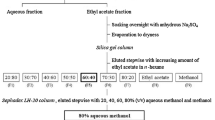Abstract
In earlier work, we found thatPolygonum aviculare had pronounced allelopathic effects against several test species. Four inhibitors were isolated from livingPolygonum plants, three of which were glucosides. Four different inhibitors were isolated fromPolygonum residues and soil underPolygonum stands, and none of these occurred in soil fromCynodon dactylon (L.) Pers. stands. Three of these were glycosides containing both fructose and cellobiose as the sugars. Color reactions of all the inhibitors indicated that they are phenolic in nature. All the inhibitors reduced seed germination and/or seedling growth ofChenopodium album L. Moreover some of them inhibited growth of different strains ofRhizobium andAzotobacter.
Similar content being viewed by others
References
AlSaadawi, I.S., andRice, E.L. 1982. Allelopathic effects ofPolygonum aviculare L. I. Vegetational patterning.J. Chem. Ecol. 8:993–1009.
Bray, H.A., Thorp, W.V., andWhite K. 1950. The fate of certain organic acids and amides in the rabbit 10. The application of paper chromatography to metabolic studies of hydroxybenzoic acids and amides.Biochem. J. 46:271.
Chou, C.H., andLin, H.J. 1976. Autointoxication mechanisms ofOryza sativa. I. Phytotoxic effects of decomposing rice residues in soil.J. Chem. Ecol. 2:353–367.
Einhellig, F.A., andRasmussen, J.A. 1978. Synergistic inhibitory effects of vanillic andp-hydroxybenzoic acids on radish and grain sorghum.J. Chem. Ecol. 4:425–436.
Harborne, J.B. 1977. Introduction to Ecological Biochemistry. Academic Press, New York.
Hargreaves, J.A., Mansfield, J.W., andCoxon, D.T. 1976. Conversion of wyerone to wyerol byBotrytis cineria andB. fabae in vitro.Phytochemistry 15:651–653.
Horsley, S.B. 1977. Allelopathic interference among plants. II. Physiological modes of action, pp. 93–136,in H.E. Wilcox and A.F. Hamer, (eds.). Proceedings of the Fourth North American Forest Biology Workshop. School of Continuing Education. College of Environmental Sciences and Forestry, Syracuse, New York.
Ingham, J.L. 1976. Fungal modification of petercarpan phytoalexins fromMelilotus alba andTrifolium pratense.Phytochemistry 15:1489–1495.
Koeppe, D.E., Rohrbaugh, L.M., andWender, S.H. 1969. The effects of varying UV intensities on the concentration of scopolin and caffeoylquinic acids in tobacco and sunflower.Phytochemistry 8:889–896.
Lodhi, M.A.K. 1976. Role of allelopathy as expressed by dominating trees in a lowland forest in controlling productivity and pattern of herbaceous growth.Am. J. Bot. 63:1–8.
Muller, C.H., 1966. The role of chemical inhibition (allelopathy) in vegetational composition.Bull. Torrey Bot. Club 93:332–351.
Nagvi, H.H., andMuller, C.H. 1972. Biochemical inhibition (allelopathy) exhibited by Italian ryegrass.Pak. J. Bot. 7:139–147.
Newman, E.I., andMiller, M.H. 1977. Allelopathy among some British grassland species II. Influence of root exudates on phosphorus uptake.J. Ecol. 65:399–411.
Rasmussen, J.A., andEinhellig, F.A. 1977. Synergistic inhibitory effects ofp-coumaric and ferulic acids on germination and growth of sorghum.J. Chem. Ecol. 3:197–205.
Rice, E.L. 1965a. Inhibition of nitrogen-fixing and nitrifying bacteria by seed plants. II. Characterization and identification of inhibitors.Physiol. Plant. 18:255–268.
Rice, E.L. 1965b. Inhibition of nitrogen-fixing and nitrifying bacteria by seed plants. III. Comparison of three species ofEuphorbia.Proc. Okla. Acad. Sci. 45:43–44.
Rice, E.L. 1974. Allelopathy. Academic Press. New York.
Rice, E.L. 1979. Allelopathy. An update.Bot. Rev. 45:15–109.
Rice, E.L., andPancholy, S.K. 1974. Inhibition of nitrification by climax ecosystems. III. Inhibitors other than tannins.Am. J. Bot. 61:1095–1103.
Rice, E.L., Lin, C.Y., andHuang, C.Y. 1981. Effects of decomposing rice straw on growth of and nitrogen fixation byRhizobium.J. Chem. Ecol. 7:333–344.
Rovira, A.D. 1969. Plant root exudates.Bot. Rev. 35:35–59.
Smith, I. ed. 1960. Chromatographic and Electrophoretic Techniques, Vol. I, Chromatography. Interscience Publishers, Inc., New York.
Society of American Bacteriologists. 1957. Manual of Microbiological Methods. McGraw-Hill, New York.
Tubbs, C.H. 1973. Allelopathic relationship between yellow birch and sugar maple seedlings.For. Sci. 19:139–145.
Van Etten, H.D., andSmith, D.A. 1975. Accumulation of antifungal isoflavonoids and α-1-hydroxy phaseollone, phaseollin metabolite, in bean tissue infected withFusarium solani f. sp.phaseoli.Physiol. Plant Pathol. 5:225–237.
Wang, T.S.C., Yang, T.K., andChuang, T.T. 1967. Soil phenolic acids as plant growth inhibitors.Soil Sci. 103:239–246.
Wilson, R.E., andRice, E.L. 1968. Allelopathy as expressed byHelianthus annuus and its role in old-field succession.Bull Torrey Bot. Club 95:432–448.
Young, C.C. 1979. Allelopathy in a grass-legume association. Ph.D. thesis. University of Hawaii, Honolulu, Hawaii.
Author information
Authors and Affiliations
Rights and permissions
About this article
Cite this article
Alsaadawi, I.S., Rice, E.L. Allelopathic effects ofPolygonum aviculare L. II. Isolation, characterization, and biological activities of phytotoxins. J Chem Ecol 8, 1011–1023 (1982). https://doi.org/10.1007/BF00987882
Received:
Revised:
Issue Date:
DOI: https://doi.org/10.1007/BF00987882




